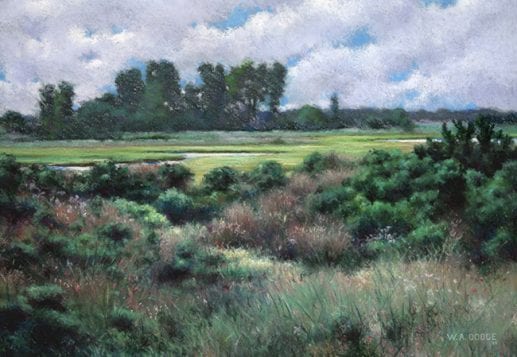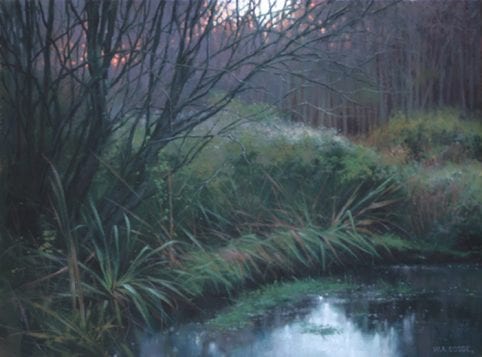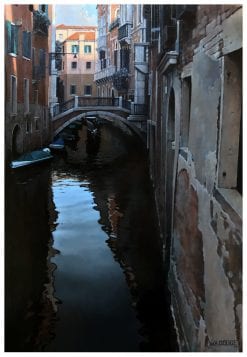‘I believe each painting has a story to tell and a connection to make. My paintings are an effort to share an experience, an emotion, or a memory of a place and time.’
By Irene Ruddock

William A. Dodge is an award-winning artist classically trained in the tradition of the old masters. He studied at the Stevenson Academy of Traditional Painting before beginning a career in illustration. He has created more than six hundred book covers for most of the major publishers in New York, as well as a wide variety of private commissions ranging from murals to portraits. He continues to paint and has been a faculty member of the Visual Communications Department at SUNY Farmingdale for more than twenty years.
As a lifelong Long Island resident, what do you enjoy about painting on the Island?
I have always enjoyed the open landscapes of the North Fork and the waterfront areas of the South Shore. We have an abundance of really diverse subjects to choose from throughout the Island. Paint what you know.
Do you have a favorite Long Island artist?
I would have to say William Merritt Chase for his paintings of Long Island. Although he probably wouldn’t qualify as an Islander, he did give us some of the finest depictions of late nineteenth century life on Long Island. His 1888 painting “Back of a Nude” is one of my all-time favorites.
Where else do you like to paint?
I like New York city street scenes, especially in the snow. I like that the muted tones help expose the composition somewhat like a black and white photo. Over the past few years, I have probably completed more paintings of Venice than any other city. People might say, “just what the world needs, another painting of Venice,” but I can’t help myself, so out they come.
What inspires you to begin a painting?
It always comes down to telling a story, capturing a moment or examining a concept.
Tell me about your common ancestor, the renowned artist William de Leftwich Dodge (1867-1935), who designed the classical Villa Francesca in Setauket.
Yes, we both share a common ancestry with Tristram Dodge (1607-1683) of New Shoreham (Block Island), Rhode Island.
How do you answer the age-old question: Are you born with extraordinary talent or is it developed?
Nature or nurture? I think it’s a little of both. Much like learning another language in a bilingual family, art and music are just different languages. I know that my skills as an artist were learned. Was I predisposed to pay attention to the specifics of painting rather than those of high finance? Probably. Is that talent? I don’t know. I do know Malcom Gladwell’s rule of Ten Thousand hours.
What is the best part of being an artist?
There is satisfaction from creating something from nothing; communicating in a purely visual sense and making a thought visible.
And the most difficult part?
Most times it’s just deciding what to paint!
What do you do if you hit a roadblock in a painting?
Most often I examine value first, then composition followed by color. I apply the rules I know to be true about each and just keep at it. Sometimes it’s a quick fix and others are happy accidents, but they are always a learning experience.
I have always let a painting progress as I go. You never know when one perfect brush stroke or the placement of the wrong color is going to change the entire direction of a painting. If painting was just a copy of a reference or a scene it would technically be easy, but that’s not art.
What did you like about your career in illustrations?
It was being able to put my interpretation of a great descriptive or pivotal moment in a book on the cover. I especially liked illustrating the classics and had to wonder what Charles Dickens would have thought of my choices.
What other artists inspire you?
I’ll start with my short list of those from the golden age of American illustration. Artists like Howard Pyle, N.C. Wyeth, Harvey Dunn, Norman Rockwell, Haddon Sundblom, and Dean Cornwell were my go to guys. I admire the English pre-Raphaelites, and I am truly inspired by the French Impressionists, especially the lesser known Henri Le Sidaner. I have always been drawn to works of Pieter Bruegel the Elder and Hieronymus Bosch.
Do you seek out opportunities to see these paintings in person?
Over the years my wife and I have traveled throughout Europe to see as many of their original works as possible. I’m fascinated by Bruegel’s sixteenth century genre paintings depicting the everyday lives and traditions of the common people. Again and again I find myself examining Bosch’s fifteenth and sixteenth century works for insights into the human psyche and the fear of those things that went bump in the night, before science explained them all away.
What advice would you give other artists?
Learn and practice the technical aspects associated with your chosen medium, but don’t mistake that for art. Art is the combination of imagination and skill. To work in a particular avenue like realism or impressionism, you need to know those rules. My advice is “Don’t allow your imagination to be hindered by a lack of technical proficiency.”
How did the Impressionists change the world of art?
Most of the late nineteenth century impressionists were classically trained artists who were able to take all of the same rules governing the traditional artistic standards such as light and shadow, values, color theory, composition and perspective and create a completely new form of art.
Being well versed in the technical aspects of their craft gave them the ability to bend the rules when needed and break the rules with authority.
There seems to be a bit of impressionism in your work. Do you feel an affinity with the artists who studied in Paris in the nineteenth century?
Affinity might not be the right word. Maybe thankful is a better choice for how I feel. Their ground breaking works gave all artists a view to a clearer path for self-expression.
I know that you have won many awards. Has there been one that has meant the most to you?
No. I think when you win an award you have to remember that you made a connection with just one person, the judge. Many of what I consider my finest works have never won anything. For myself and most artists, awards are not why we paint.
How do you wish to expand on your style?
I have gravitated towards a more impressionistic style, and I can’t think of any artist on any level that has gotten tighter as their career progressed. A quicker direct approach to “less is more” is the ultimate goal.
I see that you have three websites which point to three different aspects of your art career. Can you tell me about that?
I have www.billdodgestudios.com which is a showcase for my past illustration work.
I have www.wadodge.com which is a showcase for my current fine art.
I also have www.newthreshold.com for my woodworking and design work.
Are there future shows where we can see your work?
I will be part of the upcoming Mills Pond Gallery exhibit in St. James called Contemporary Realism which runs from September 12 through October 16. If all goes well in the world, I hope to show with the Setauket Artists in the Setauket Neighborhood House in October, the Atelier at Flowerfield in St. James in December, and Deepwells Mansion in St. James sometime in the spring.




























